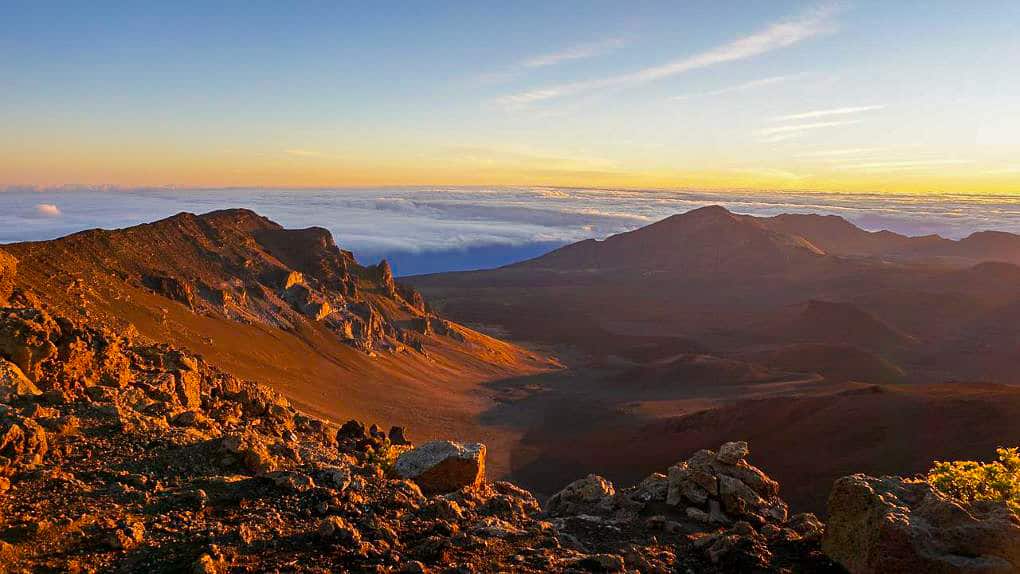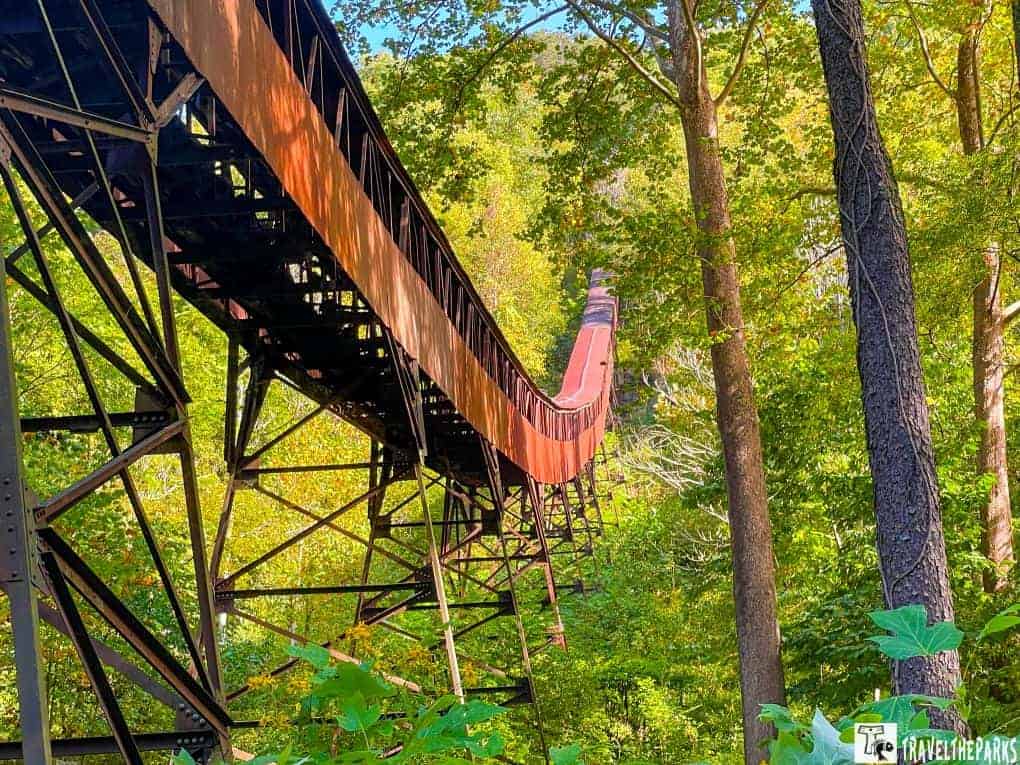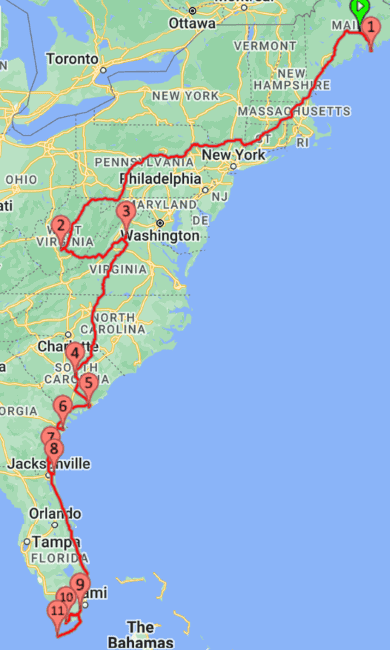
Our road trip along the east coast to visit national parks was one of the most unforgettable journeys we have embarked on to date. Each park or unit was distinctly different from the previous park. We made the trip in our camper, taking a few weeks to complete. Our trip began at Acadia National Park, and ended at Dry Tortugas National Park. The East Coast’s national parks offer endless opportunities for discovery and wonder, making every visit a new adventure.
You can use our itinerary as a starting point to create your own East Coast road trip. This itinerary does not include the stops we made at a variety of destinations, including cities, beaches, mountains, and historical sites along the way. This post would be way too long to include all 14 states along the Atlantic coast. Our rule is to drive 3-4 hours from one destination to another. This makes it easier for us and the dog. This road trip made us realize how little you need to be truly happy.

This post may contain affiliate links, meaning if you purchase something through one of these links, we may earn a small commission at no extra cost to you! Read the full disclosure policy here.
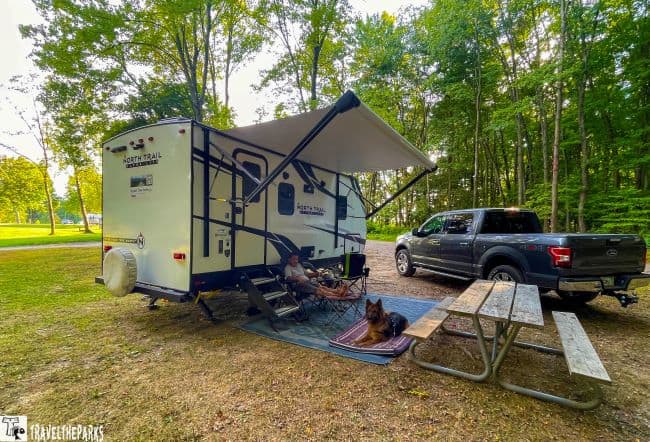
Table of Contents
East Coast National Parks Itinerary for the Perfect Road Trip
- Acadia National Park– 2-3 nights camping at Acadia National Park / Seawall Campground.
- New River Gorge National Park: 2 nights camping at Rifrafters Campground.
- Shenendoah National Park: 2-3 nights camping at Big Meadows Campground.
- Congaree National Park: 2 nights of camping at Santee Cooper State Park.
- Charleston, South Carolina-Fort Sumter and Fort Moultrie National Monument: 3 nights camping at James Island County Park.
- Fort Pulaski National Monument & Fort Frederica National Monument: 3 nights camping at Skidaway Island State Park near historic Savannah, Georgia.
- Cumberland Island National Seashore: 2 nights camping at Crooked River State Park in St. Marys.
- Timucuan Ecological and Historic Preserve: 3 nights camping at Huguenot Memorial Park in Jacksonville, Florida.
- Canaveral National Seashore: 2 nights camping at Jetty Park Beach & Pier in Port Canaveral.
- Key Biscayne National Park: 2 nights camping at Larry & Penny Thompson Park Campground.
- Everglades National Park: 3 nights camping at Flamingo Campground, 2 nights at Trail Lakes Campground and 1 night at Midway Campground.
- Dry Tortugas National Park: 3 nights of camping at Bahia Honda State Park.

Wondering when to plan an East Coast national parks road trip?
It’s important to consider the best time of year to explore these scenic destinations. Each season brings a different perspective to the national parks. We did this beginning in spring in Maine and ending in late fall in Florida. Fall is an ideal time to see Acadia, New River and Shenandoah, but it is also when these parks draw the largest crowds. Summer is also a busy time, with wait times for Acadia National Park being a few hours. Packing your patience is imperative during the warmer months. Although we did the mid-Atlantic parks at the height of summer, we chose early morning or late afternoon for most of our excursions. Since we live in Florida, we knew the southern parks were just too hot in summer but are manageable in late fall. Not to mention the mosquitoes and other bugs.
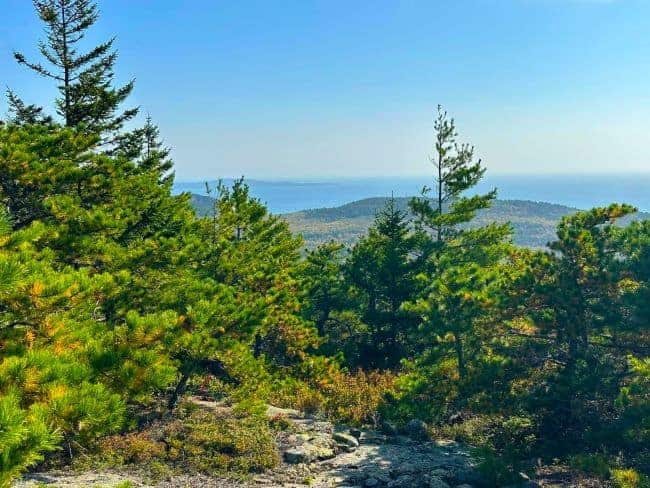
TIP: The $80 America the Beautiful National Park and Federal Recreational Lands Pass provides access to over 2,000 federal recreation sites nationwide. This pass can save you money, especially if you plan to visit multiple parks throughout the year. Plus, your purchase supports the preservation and maintenance of these natural wonders. Investing in the annual pass is a great way to enjoy the great outdoors to the fullest.
East Coast Beauty: Acadia National Park
Overview: If possible, begin your journey along the rugged coastline of Acadia National Park in Maine. This park is impressive, covering an area of about 49,000 acres. Its most renown land feature is Cadillac Mountain, the highest point on the U.S. Atlantic coast. The park also includes historical sites such as the Jordan Pond House and the historic carriage roads, which were built by John D. Rockefeller Jr.
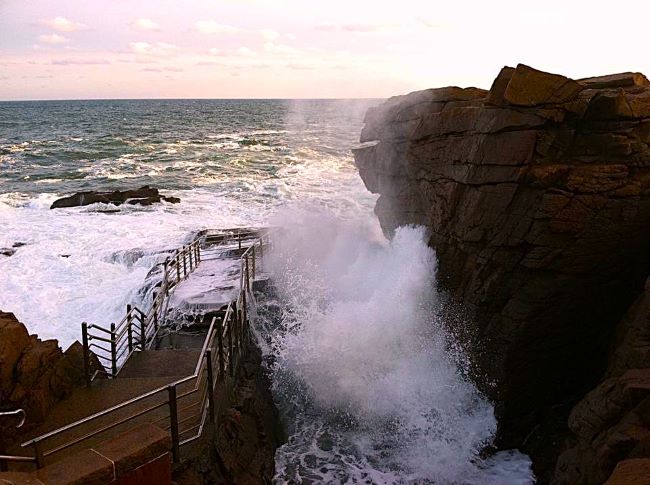
Best Things to Do: If you are a landlubber, there are over 120-miles of hiking trails in this park. Popular trails include the Jordan Pond Path and the Precipice Trail. Kayaking, paddleboarding, or a boat tour are available for water lovers in the park. This is by far the best way to see the iconic Bass Harbor Head Lighthouse. Whatever you choose to do, we are sure you will have an amazing time at Acadia National Park. One thing to note about Acadia is that if you plan to drive to the top of Cadillac Mountain, a vehicle reservation is required for Cadillac Summit Road from May through October. Cadillac Mountain is among the first in the US to see the sunrise, a great spot.
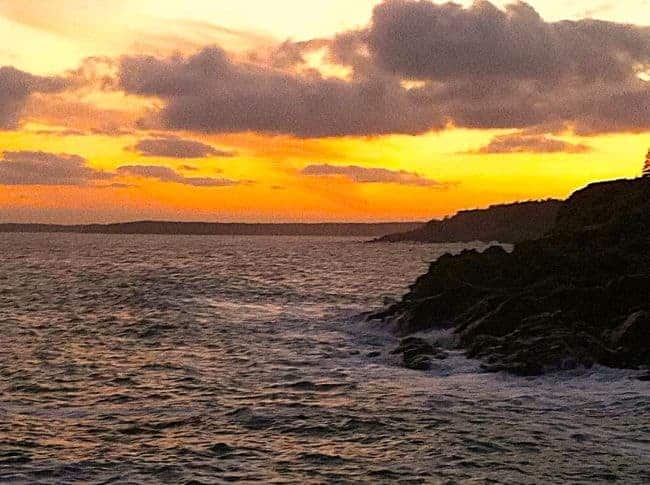
Our favorite memory of Acadia National Park
We started early morning, driving the one-way, 27-mile scenic Park Loop Road. It winds along Acadia’s rugged coastline, guiding visitors past must-see attractions like the dramatic Thunder Hole and towering Otter Cliffs. It was so quiet this early in the spring. All we heard was the sound of the waves crashing on the shoreline. The ever-changing scenery along this road is definitely spellbinding in any season. I can only imagine how beautiful it would be in the fall. The colors would be amazing, but there is something to be said for early spring flowers like the trillium and lady slippers.
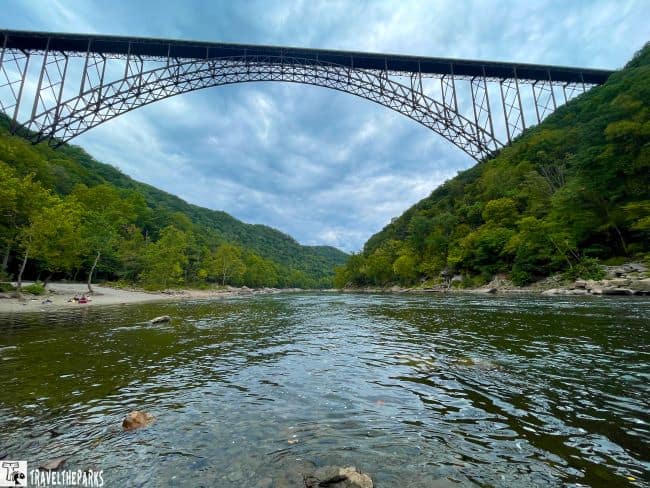
TIP: Prepare for unexpected delays or roadside emergencies by packing essential items like water, snacks, a first-aid kit, and other emergency supplies.
East Coast Adventure: New River Gorge National Park & Preserve
Overview: Established in 1978, New River Gorge became the 63rd National Park in 2000. A 70,000-acre wonderland, it is a West Virginia crown jewel. The park follows 53-miles of the New River. The centerpiece river has carved the 800 foot deep gorge over millions of years. If you ever find yourself in this park, you have to check out the New River Gorge Bridge. It’s super long, like 3030 feet long! Hard to believe it’s the third longest single arch bridge in the world.

Best Things to Do: The New River Gorge offers a wealth of thrilling activities for adventurous visitors. Daring thrill-seekers can step out onto the bridge, a true engineering marvel, and walk high above the river on the scaffolding. For outdoor enthusiasts, the park provides fantastic hiking, rock climbing, and whitewater rafting opportunities. Avid fly fishers will find an abundance of trout in the park’s clear, flowing streams. Our favorite pastime is fishing. There is no more perfect setting than the New River and its tributaries.
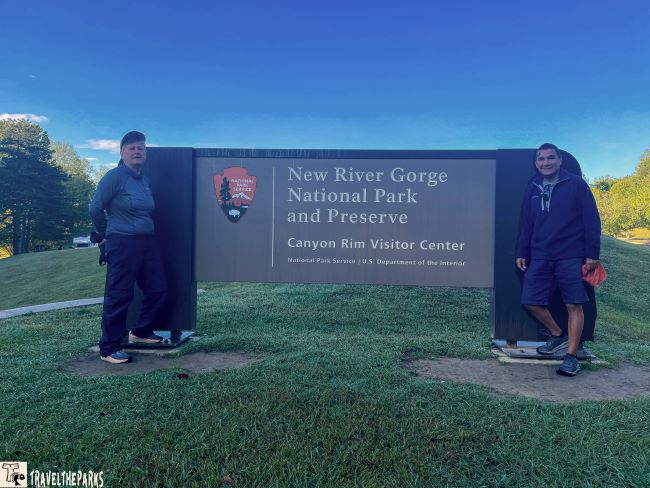
Our favorite memory at New River Gorge National Park
Exploring the historical towns dotting the New River Gorge remains one of my fondest memories. Once a bustling railroad town, Thurmond supported the coal industry. By 1910, it had become the C&O’s primary railroad hub, generating more revenue than the combined totals of major cities like Cincinnati and Richmond. But my favorite was Nuttallburg. A coal mining town, it ceased production in 1958. The company left behind a collection of buildings and remnants of the mining infrastructure. Today, it’s one of the best examples of a coal mining complex preserved in the state. Both had a vibe like a “ghost town.”
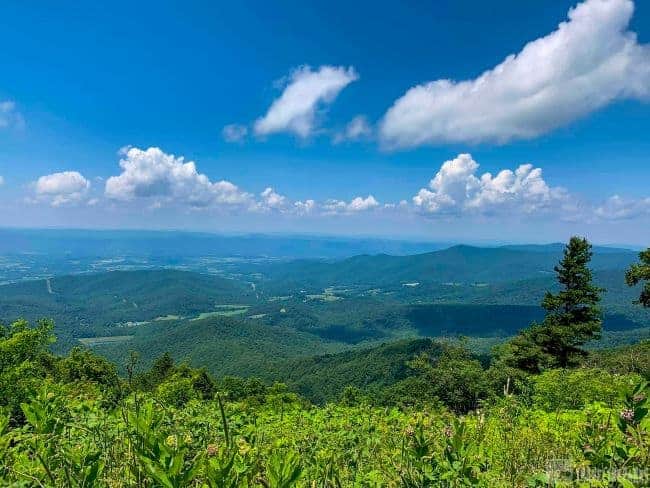
East Coast Panoramas: Shenandoah National Park
Overview: Shenandoah National Park was an easy side trip we took in Virginia. The rolling Blue Ridge Mountains characterize this park. Driving the 105-mile Skyline Drive from one end to the other, we found that around every corner; it seemed there was another breathtaking vista. While we were visiting the park, even from our car, we had many opportunities to spot black bears or white-tailed deer. Moreover, in case you are a plant lover, this park is full of more than 1,400 varieties of wildflowers.

Best Things to Do: The park is a haven for outdoor activities. Whether you prefer fly-fishing the Shenandoah River or finding a secluded mountain trail, or spelunking the Luray Caverns, this park has something to engage everyone. With over 500-miles of hiking trails, they range from easy to challenging. Our favorites were Old Rag Mountain, Bearfence Mountain, Rapidan Camp and Dark Hollow Falls. It was very exciting on the Bearfence rock scramble. We saw a timber rattlesnake! If you have additional days, consider adding Luray Caverns. It is a fascinating venture into the underworld.

Our Favorite Memory: Fishing in Shenandoah National Park
I have fond memories of the peaceful moments I spent fly fishing for smallmouth bass along the serene waters of the Shenandoah River. The experience of the fish taking the fly and the excitement of the fight while enjoying the beauty of the river were truly amazing. I must say that on a sweltering summer day, wading through the cool river waters provided a refreshing respite from the heat.
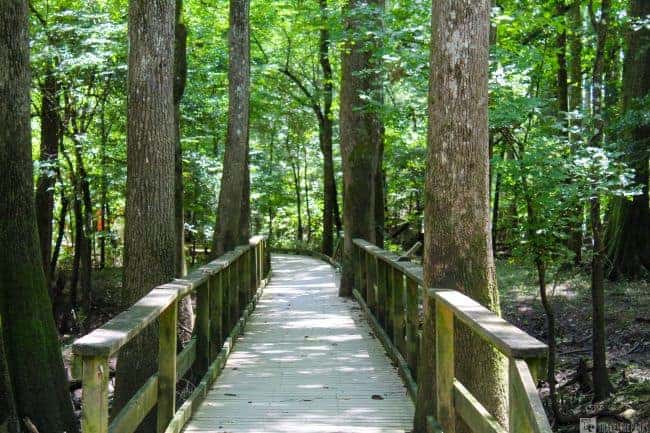
TIP: If your travel schedule allows, consider taking a side trip to Washington, D.C. to visit the iconic national monuments and memorials.
East Coast Old-Growth Trees: Congaree National Park
Overview: Congaree National Park is home to some of the oldest and tallest trees on the East Coast. These old-growth trees have been standing tall for hundreds of years. They provide shelter and food for a variety of wildlife. Although the park is a fairly small one, measuring 27,000 acres, we could not help being amazed at the grandeur of those ancient giants as we hiked along the boardwalk. (Before I became a teacher, I had a forestry major, so I have a long love of trees). In July, we were there almost alone with the park. It is a perfect place to reestablish the lost bond with nature and recognize the need to save these stunning trees for the coming generations.

Best Things to Do: While there may not be a plethora of activities available, Congaree, we considered this park to be truly unique. For instance, Congaree boasts 25-miles of scenic hiking trails to explore. This park, being a floodplain swamp, can be a challenge when water levels are high. Summer is the rain season, so some trails will be impassable. Despite the limited options, we fully embraced the beauty of this hidden gem, hiking multiple trails .
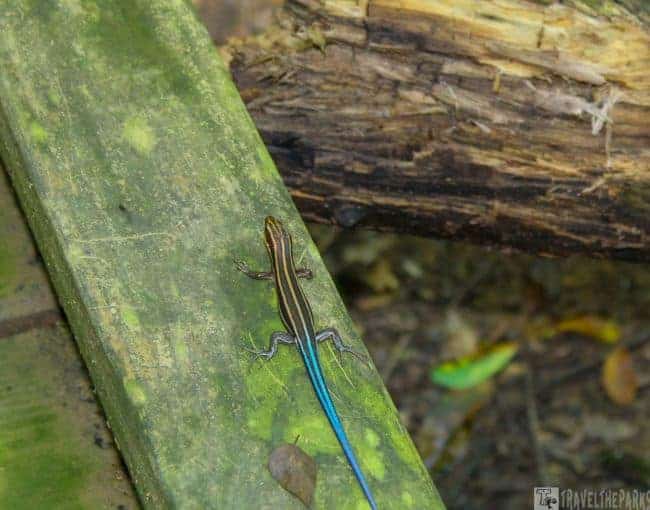
Our Favorite Memory in Congaree National Park
One of the best-kept secrets to enjoying this park is the kayaking and canoeing opportunities. Paddling the 15-mile Cedar Creek Canoe Trail is an excellent way to experience Congaree. We booked a 3-hour guided trip with J.K. Adventure Guides. We had so much fun! Our guide told us some interesting stories, especially about his wildlife encounters. On this trip we saw lots of snakes (no moccasins), a raccoon, a barred owl and a few skinks. Even in hot July, the mosquitoes were only a 3 on the mosquito meter.
NOTE: When you’re out hiking in the hot sun, be sure to protect yourself from getting sunburned by wearing sunscreen and a hat. It’s easy to get dehydrated in the summer heat, so be sure to drink plenty of water – about two quarts per hour. Don’t forget to bring binoculars to spot wildlife in the park. Wear sturdy hiking boots for a comfortable and safe trek. To enhance your experience, download the free NPS app before you start your national park adventure.

Exploring History: Fort Sumter and Fort Moultrie National Monument
Overview: We just love historical forts, especially the third system of U.S. fortifications, such as Fort Pickens, Fort Barrancas and Fort Clinch. If you are interested in history, exploring Fort Sumter and Fort Moultrie National Monument is a place that tells an important story of the pivotal events that marked the beginning of the Civil War. The Battle of Fort Sumter took place from April 12 to 14, 1861, marking the official beginning of the American Civil War. It was a big deal because the war lasted for four years. Over 620,000 people died during the war. Evidently, it eventually led to the freedom of 3.9 million enslaved people.
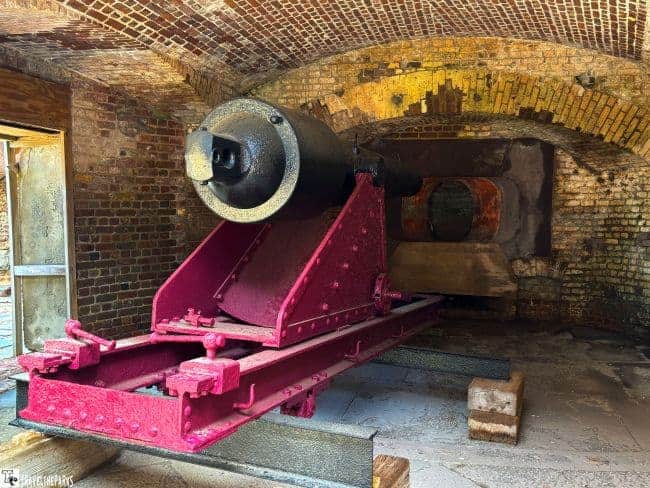
Best Things to Do: In the middle of Charleston Harbor, the fort is a 20-minute ferry ride. Plan to spend at least 2-3 hours and enjoy the beautiful views of the harbor and surrounding area on the ride. Visitors can then explore the fort and learn about the events that led to the war in the visitor center. While heading back to the ferry, make a stop at the beach to appreciate the downtown Charleston view. Fort Moultrie on Sullivan’s Island is another worthwhile fort to visit.
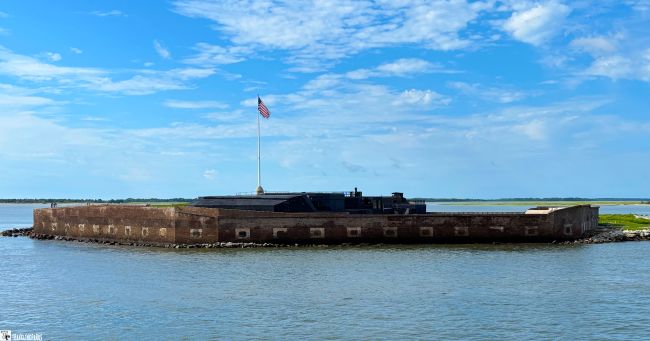
Our Favorite Memory: A Fort Sumter Patriotic Experience
The first ferry of the day was ours, and we were very fortunate to have it. We ascended the stairs to the top after we had gotten there. The flag-raising event was the only thing we could see from this height. As the flag was being hoisted, a slight gust of wind brought with it the historical echoes. The silence among the watchers emphasized the solemnity of the ceremony. I was reflecting on the fort’s role in the Civil War and the courage of those who had been here over a hundred years ago. The flag raising at Fort Sumter is one of those events that evoke a variety of feelings that remind us of the United States of America and the sacrifices made by men to protect it.
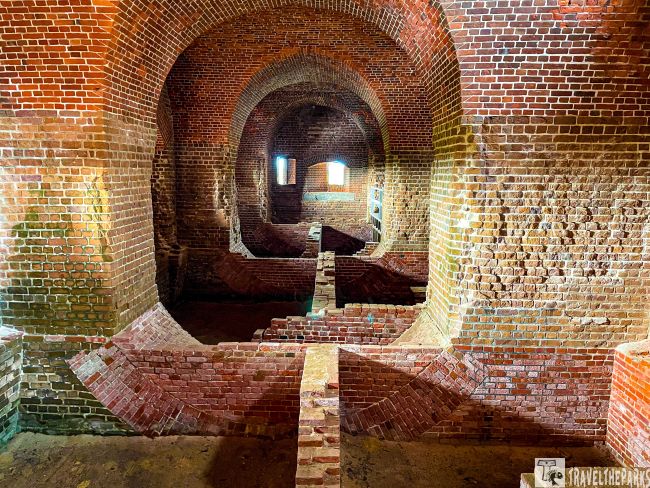
Historic Gems of the Southeast: Fort Pulaski National Monument & Fort Frederica National Monument
Overview: Fort Pulaski National Monument is a historic site near Savannah, Georgia, that played a significant role during the Civil War. The Union Army used the fort to defend against Confederate forces. However, after a prolonged siege, the fort eventually fell. Visitors can explore the fort’s grounds, including its impressive walls and moat, while learning about the history of the area. Fort Frederica National Monument, on the other hand, is on St. Simon Island, Georgia. It showcases the remains of a colonial town established by the British in the 18th century. Visitors can see the ruins of buildings and learn about the town’s role in shaping the history of the region. Both monuments offer a glimpse into the past and provide a unique opportunity to learn about different aspects of American history.
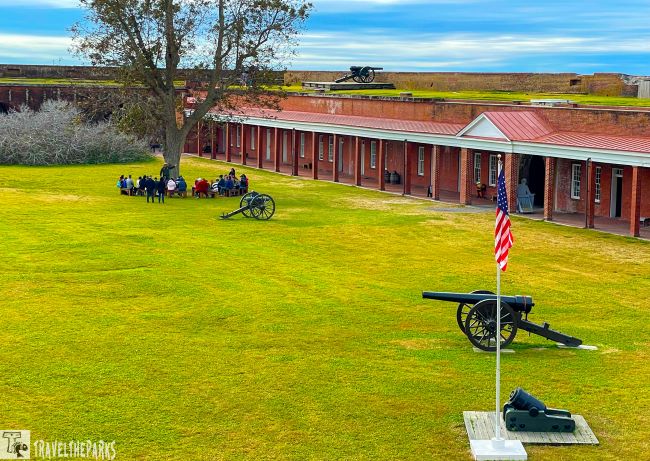
Best Things to Do: When visiting Fort Pulaski and Fort Frederica, there are so many fun things to do! Wandering the sprawling grounds of Fort Pulaski, we discover reenactments that bring the fort’s storied past to life. Interactive exhibits told us about the innovative construction techniques used to build its formidable walls. On a perimeter tour, we learned about the dramatic 1862 bombardment that ultimately led to its surrender. Beyond the fort itself, the short hiking trail to Cockspur Island or the outside batteries.
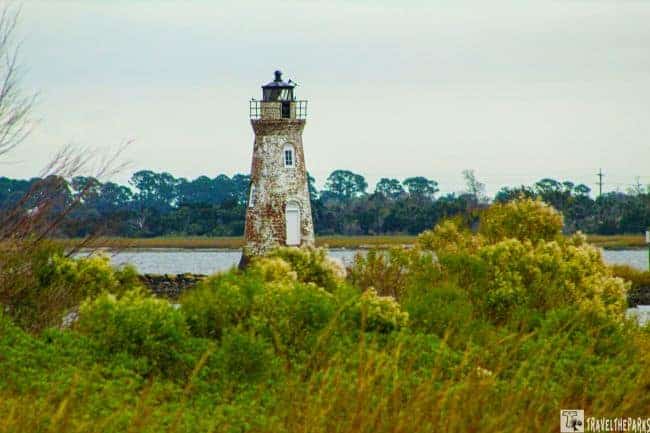
At Fort Frederica, we hiked the trails, toured the archaeological excavations, and imagined the bustling activity that once filled this strategic outpost. If you have the time, take a guided tour to hear fascinating stories and see interesting artifacts. Don’t forget to check out the beautiful views and maybe even have a picnic. It’s a great way to spend a day outdoors!

Our Favorite Memory: The Thrill of Live Cannon Firing
I have to say that it was when I witnessed the live cannon demonstration at the historical reenactment event at Fort Pulaski. The loud boom of the cannon echoing through the air gave me a start, not to mention the sight of the smoke billowing out was mesmerizing. It was amazing to see how powerful and destructive these weapons used to be. The experience made me appreciate the bravery of soldiers who had to face such weaponry in battle. Heart pumping, it was a thrilling and unforgettable moment that I will always appreciate.
TIP: A side trip to walk the cobblestone streets of Savannah or climb the 273 steps to the top of the Tybee Island Lighthouse makes for a memorable addition to your travel itinerary.
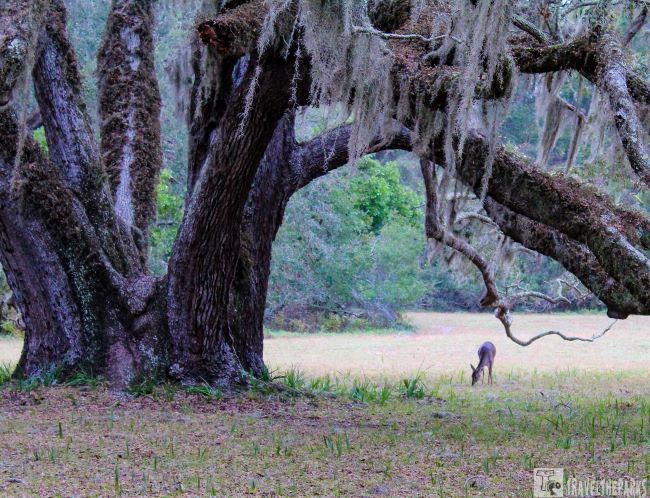
A Coastal Haven: Cumberland Island National Seashore
Overview: Just off the southeastern coast of Georgia, spanning 36,000 acres, lies the impressive Cumberland Island National Seashore. This remote barrier island has miles of untouched, powdery sand beaches. The island is most renown for its iconic wild horses roaming freely across the island. They are Cumberland, descendants of domesticated horses that were brought to the island centuries ago. For those seeking to escape the crowd, the island is accessible only by ferry from St. Marys. Getting to this Georgia coast island only adds to the unspoiled beauty of the island.
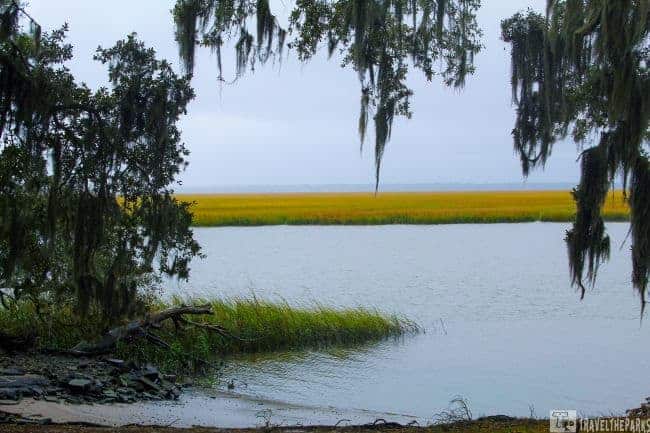
Best Things to Do: What I loved most about this national seashore was the ability to immerse ourselves in nature. Hiking the island’s network of trails took us through a mix of maritime forest, salt marsh and sandy beachfronts. Biking along the sandy paths is a popular activity, with rentals available in St Marys. To reach Plum Orchard mansion, it is 5-miles (one-way). The coastal drive is quite beautiful. It is lined with towering live oak trees draped in wispy Spanish moss. It is a relatively flat trail, making it accessible for most riders. For a longer adventure, consider camping beneath the canopy of stars that illuminate the night sky.

Our favorite memory: visiting the grand Gilded Age mansions
Taking the Land and Legacies Tour gets you beyond the beaches. First, reservations are a must for both the ferry and the Land and Legacies Tour. The Plum Orchard mansion was a highlight of our tour. Having Mike Fulford as our knowledgeable guide made the experience even more enjoyable. He brought the mansion’s history to life with his captivating storytelling. Wandering through the grand rooms was an exceptional experience. Having a picnic lunch surrounded by wild horses grazing on the lawn was pretty spectacular.

Afterwards, Mike gave us plenty of time to explore Dungeness Mansion, built by Thomas Carnegie in the 1880s, which was known for its opulence and grandeur. Fire destroyed the mansion in 1959. The skeletal ruins of Dungeness are a haunting reminder of Cumberland’s storied past. Today, the remaining stone walls, overgrown with ivy, felt otherworldly to me. I would highly recommend this tour to anyone looking to learn more about the rich history of the area.

Exploring the Timucuan Ecological and Historic Preserve
Overview: Just outside Jacksonville, Florida, following the “Buccaneer Trail,” you will come across the Timucuan Ecological and Historic Preserve. Encompassing 46,000 acres, the preserve features several significant historical sites, including the Fort Caroline National Memorial and Kingsley Plantation. Fort Carolina celebrates the 16th-century French Huguenot settlement, a pioneering European colony in North America. Kingsley Plantation offers insights into Florida’s plantation era and the lives of enslaved people. A former cotton plantation, this site includes the restored plantation house, historic slave quarters, tabby ruins, and a barn.
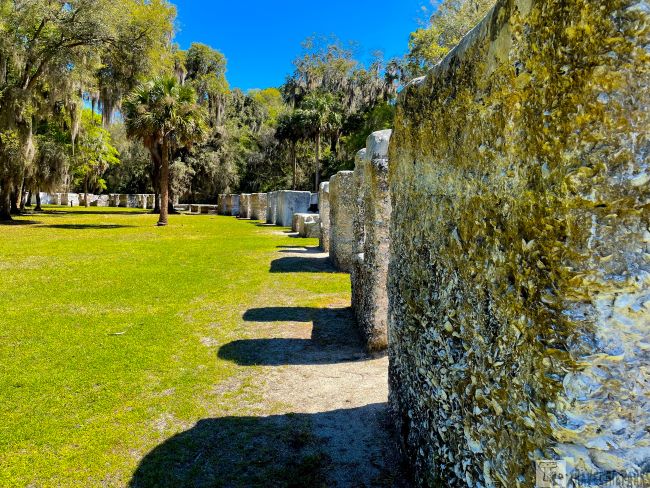
Best Things to Do: Visitors can enjoy a range of outdoor activities such as hiking, canoeing, kayaking, and wildlife viewing. We took advantage of the preserve’s varied network of trails and waterways that provide access to its diverse environments. The preserve’s visitor center provides educational exhibits and information about the Timucua people and the area’s indigenous inhabitants. Both Fort Carolina and Kingsley Plantation have historic structures to tour.

Our Favorite Memory: A Walk on Boneyard Beach
Walking on Boneyard Beach is one of our favorite memories. The way the sun shines on the bleached remains of trees that line the shoreline is a photographer’s dream. With so little wind, the sound of the waves lapping against the shore created a peaceful atmosphere. As we strolled along the sandy coastline, I loved collecting random shells and pieces of driftwood. The beach is ours alone today. It’s a special place where you can escape from the hustle and bustle of everyday life. I will always remember the memories we created on Boneyard Beach.
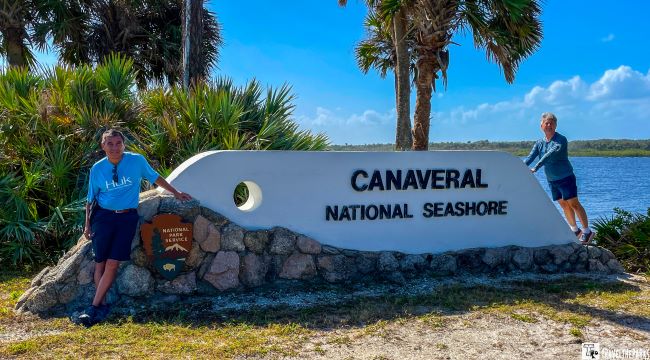
Exploring Canaveral National Seashore: A Hidden Gem of Florida
Overview: Canaveral National Seashore is a fascinating area of untouched beach filled with natural beauty and history. It includes more than 24 miles of safe beaches, salt marshes and areas full of wildlife. It provides a peaceful getaway for both nature lovers and adventure seekers. Canaveral National Seashore has a mix of different ecosystems, lots of animals and historic places, making it a fantastic spot for anyone who wants to experience Florida’s nature.

Best Things to Do: Canaveral National Seashore is a must-visit for anyone exploring the Space Coast of Florida. At the Apollo Visitor Center or Eldora State House, both on the Mosquito Lagoon, look for dolphins or manatees near the dock areas. If you have time, rent a kayak. These calm waters offer a chance to get close to nature and spot wildlife, including manatees, dolphins, and a variety of bird species. We saw plenty of people surf fishing from the beach or casting from the docks in the lagoon. Some caught mullet the afternoon we visited the park. The beach is a big draw, especially on launch day at the Kennedy Space Center.

At the Kennedy Space Center you can explore historic launch pads, view real spacecraft and learn about NASA’s missions, if time permits. Make sure to see the special display of the Space Shuttle Atlantis and the ceremony for new members in the Astronaut Hall of Fame. Additionally, consider adding time to your itinerary to see the Brevard Zoo or the Merritt Island National Wildlife Refuge.

A Favorite Memory: Seminole Rest
Among my favorite memories of visiting the Canaveral National Seashore-was an exploration of Seminole Rest. This historic site, which sits beside the Indian River, offers the visitor a look into Florida’s past. The ancient mounds stand as a testament to the earliest inhabitants and the importance of the area in Native American history. A stroll through this serene spot almost brings with it the whispers of the past, with the serene views of the river and surrounding wilderness. This place balances history, natural beauty, and peace in just the right measure.
PRO Tip: During the winter months, manatees gather here in large numbers. You can also see them in the nearby Haulover Canal and Titusville areas, where the waters stay warmer.

East Coast River of Grass: Everglades National Park
Overview: Everglades National Park, often referred to as the “River of Grass,” is a vast sawgrass marsh ecosystem that encompasses over 1.5 million acres of subtropical wilderness. The park is a World Heritage Site, a Wetland of International Importance, and a designated Biosphere Reserve. The park is home to an array of wildlife, including American alligators, West Indian manatees, and a multitude of bird species like the roseate spoonbill and the endangered Florida panther. This park is a one-of-a-kind natural treasure.

Best Things to Do: The park offers a wealth of activities for visitors, including hiking, birdwatching, and paddling. When visiting, be sure to check out the popular Anhinga Trail and Shark Valley, where you can take a tram tour or bike the loop road. Hiking options range from self-guided tours to ranger-led excursions. In the Flamingo area, boat cruises provide the best way to explore the mangrove backwaters, while airboat rides are a must-do in the Shark Valley and the Gulf Islands sections. We have been to the park multiple times, and it continues to surprise us every visit.

Our Favorite Memory: Everglades Nike Missile Tour
The Nike Missile Tour at Everglades National Park was undoubtedly one of our standout experiences. Who would have expected this little-known chapter of the Cold War to be nestled within the stunning natural beauty of the Everglades? As we walked through the abandoned missile site, the juxtaposition of these military structures against the serene backdrop was striking. We were transported back in time, imagining when the missiles at this site had stood as silent sentinels during a tense period in history. The tour provided an insightful narrative, detailing the strategic importance of these sites and the technological advancements of the era. It was sobering to realize just how close we had come to launching these “titans.” The experience sent a palpable chill down our spines. For me, this tour was more than just a historical excursion – it was a thought-provoking journey into a pivotal moment of the 20th century.
Prepare for Weather: The subtropical climate can be hot/humid, especially in the summer. Bring plenty of water, sunscreen, and insect repellent, and dress in light, breathable clothing.
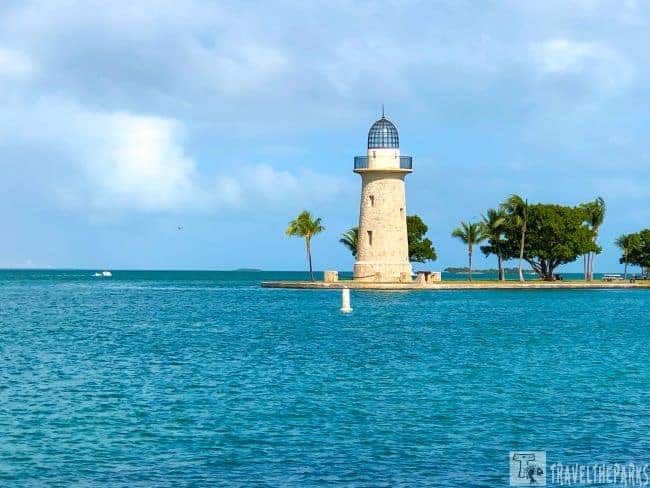
East Coast Beach & Reef: Biscayne National Park
Overview: Biscayne National Park is an oasis of sandy beaches just a few miles south and east of Miami. It is the largest marine sanctuary; it covers over 173,000 acres. Ninety percent of the park encompasses emerald green waters, secluded mangrove islands, and vibrant coral reefs.
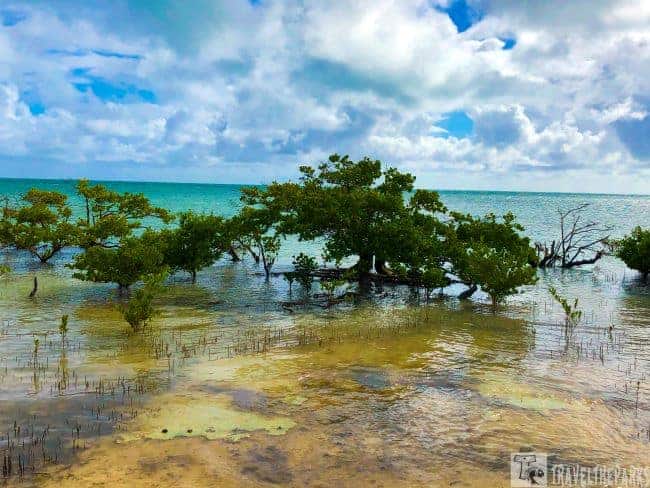
Best Things to Do: The first place to begin your adventure is the Dante Fascell Visitor Center. Through the many exhibits, they provide an introduction to the park’s natural and cultural history. From here you can rent a boat, join a guided tour, or take a ferry to reach the park’s outer islands and coral reefs. The park’s coral reefs offer some of the best snorkeling and diving opportunities in the Florida Keys. Paddling through Biscayne Bay’s mangroves and shallow waters is another great way to explore these waters. We put on our snorkeling gear and jumped into the park’s crystal-clear waters, where we could see the colorful schools of tropical fish swimming between the mangrove roots. The color of the water is indescribable.

Our Favorite Memory: Biscayne By Institute Boat Cruise
The Boca Chita Key cruise was one highlight of our visit to Biscayne National Park. This small, picturesque island features a historic lighthouse and stunning views of the Miami skyline. Our knowledgeable tour guides were the standout part of the experience, sharing fascinating stories about the park’s history and insights into the local marine ecosystem. We also spotted dolphins, birds, and other wildlife, which was a bonus. The only downside was the lack of shade on the short hiking trail, so be sure to apply sunscreen. Overall, the Boca Chita Key cruise made for an unforgettable adventure during our time at the park.
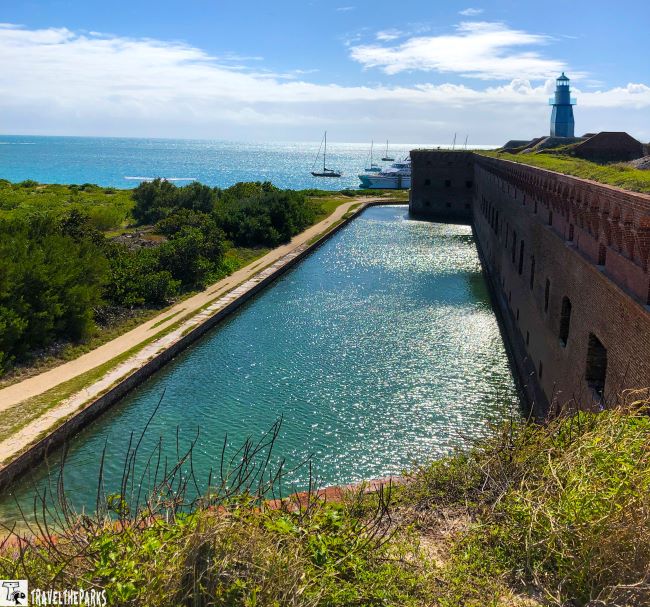
East Coast Historic Fort: Dry Tortugas National Park
Overview: Dry Tortugas National Park is a hidden gem 70-miles off the end of the Florida Keys. The park comprises seven small islands, with the impressive Fort Jefferson dominating the largest one. To reach this remote paradise, you will need to take either a seaplane or hop aboard the Yankee Freedom Ferry. Although it may be a bit pricey and require some effort to get there, the experience of exploring this historic fortress and enjoying the untouched beaches is well worth it. We took the opportunity to go to Key West, Florida, and took the Yankee Freedom Ferry out to the park. For us, it was the least expensive option. For the adventurous soul, there is plenty to do on this island oasis.
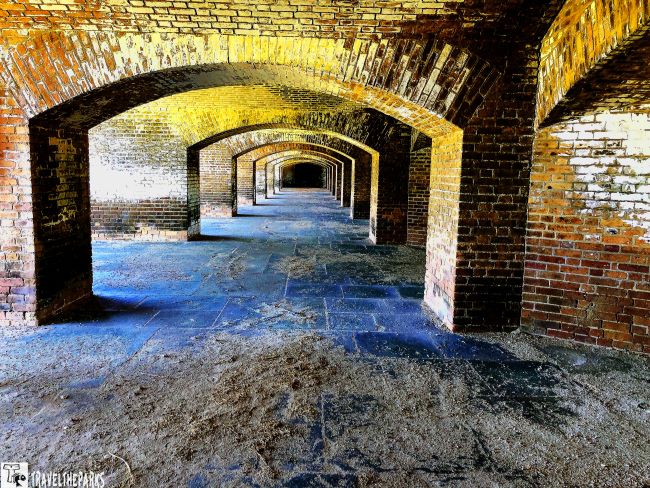
Best Things to Do: This park is most famous for its crystal-clear waters, colorful coral reefs loaded with rich marine life. The primary draw for most visitors is enjoying snorkeling, scuba diving and swimming in these turquoise waters. Birdwatching is another common pastime, with species like magnificent frigate birds, brown pelicans, and the elusive roseate tern making their homes among the park’s isolated islands. The most fascinating highlight of the park is, of course, the historic Fort Jefferson. With a rich history dating back to the early 1800s, it offers a glimpse into the past. Camping is also available on the island, providing a rare opportunity to experience the beauty of the park after hours when all day-trippers are gone.
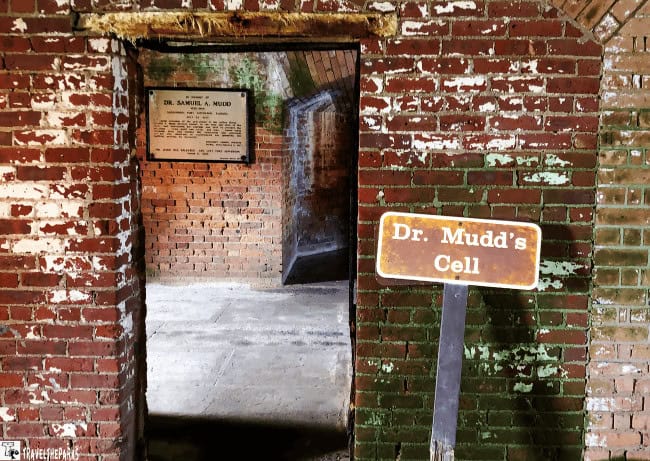
Our Best Memory of Dry Tortugas National Park
During a tour of the fort, the disclosure that it had been a military prison came as a shock to me. Wandering through the fort, I explored the labyrinth of corridors and spacious casemates until I discovered the cell of Dr. Mudd. Samuel Alexander Mudd, a doctor, gained recognition for treating John Wilkes Booth’s leg following President Abraham Lincoln’s assassination. There is ongoing debate about Mudd’s awareness of the conspiracy, which led to his trial and conviction as a co-conspirator. He received a life sentence-confining him at Fort Jefferson in the Dry Tortugas. In our opinion, if this park is not on your radar, it should be. Dry Tortugas National Park is a must-visit destination for nature lovers and history buffs alike.
TIP: If taking the ferry be sure to pack these essential items: arain jacket, dry bag, anti-nausea acupressure wristband, sturdy walking shoes or boots, sunglasses, towel, a camera withextra memory cards, long-sleeve shirts, and don’t forgetmosquito repellent and sunscreen along with a sun hat for your journey. Some items can be purchased on board the ship or at the National Park store $$$.

Final Thoughts: The Best Road Trip Featuring East Coast National Parks
As we conclude this remarkable road trip along the East Coast, it’s clear that our journey has been nothing short of extraordinary. From the rugged cliffs of Acadia National Park to the serene wetlands of the Everglades, every stop has provided its own special experience. Though we’ve covered many highlights, there are countless other National Park units waiting to be explored. While it’s impossible to cover every single park in one go, I wanted to cover the key features of our trip without making it too lengthy in this post. Wrapping up our East Coast national parks road trip feels incredibly rewarding. Ending our journey at Dry Tortugas National Park, we witnessed one last awe-inspiring sunset, the perfect capstone to our adventure.
The open road of an East Coast adventure beckons. What’s holding you back? Any favorite moments or parks from your journey that stood out? Share your thoughts and comments below.



